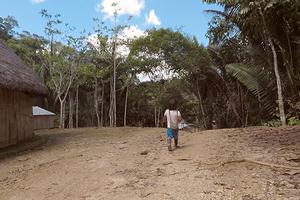Environment
Who Speaks for Nature? New Film and Book Focus on Environmental Views of Ecuador's Indigenous People

AU School of Public Affairs (SPA) Professor Todd Eisenstadt traveled to Ecuador in 2017 to discover how the local people were reacting to oil extraction and mining efforts in the Amazon rainforest. Through survey data, he learned that in parts of the country damaged by oil spills, citizen concern about the environment took a back seat to immediate economic, migration, and public health issues.
The result of Eisenstadt’s research with SUNY Geneseo Professor Karleen West was presented in a documentary, “Who Speaks for Nature? Indigenous Movements, Public Opinion, and the Petro-State in Ecuador,” screened on campus on Oct. 15.
In spring 2019, Oxford Press will publish a book by the same title.
Larry Engel, associate professor in the AU School of Communication, produced the film with funding from SPA. Filmed with a basic GoPro video camera and iPhone 6, the AU team originally planned to capture some limited footage to promote the book and broaden the audience. But after a 2017 trip to the region, there was enough material for a 35-minute documentary – one version of the film in English, one in Spanish – that conveys the compelling stories and tension among environmental advocates, developers, and indigenous people affected by the actions of multinational corporations.
The researchers compared three regions of Ecuador to show how communities reacted differently to the threat of oil extraction and its impact on broader environmental values. In some parts of the country, locals were able to organize to fend off developers and maintain a close connection with nature. In another part of the country, portrayed on film, Eisenstadt walks through open oil pits that have polluted drinking water and forced people off their land.
“It’s devastating to see how the oil flows in to river. It’s no surprise people start to feel hopeless as a result of it,” says West on camera.
Eisenstadt says the survey results who that the environment to be saved before it gets destroyed. “If the environment is degraded, of course, that’s objectively bad, but it also discourages people from caring about the environment,” he says. “If it discourages indigenous people who live off that land, then what does that say about the rest of us?”
The book confirms that indigenous people care more about the environment, so Eisenstadt says it’s troubling if they lose hope about protecting their surroundings.
“That’s the lesson. We need to organize now, for a range of reasons, but also because it helps our morale,” says Eisenstadt. “Our morale is lost with the destruction of the environment. We lose sight of the big picture.”
In the discussion after the screening, Luis Felipe Duchicela, former World Bank global advisor on indigenous peoples and former Minister of Indigenous Peoples’ Affairs for the government of Ecuador, suggested a holistic, integrated approach is needed to saving the environment and to development. The key is for indigenous people to have self-determination and be partners in decisions about how their land is used. Duchicela recommended helping build the capacity of local advocacy groups to speak from their own platforms, rather than supporting nonprofit organizations that have broader agendas with environmental protection as just one element of their work.